Philip Tan
- Problem Set #1
|
Part 1
|
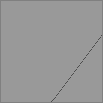 p1.dbn p1.dbn |
paper 40
repeat a 0 100
{
set b (a+b/4)
set [(a+50) b] 70
}
|
| |
Create a program to draw a carefully chosen one line on a paper of your choice.
|
Part 2
|
  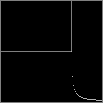 p2.dbn p2.dbn |
paper 100
set a 50
pen a
line ((a*2)-30) (a+a) (a+20) a
line ((a-50)*3) a (a+20) a
repeat b 1 50
{
set [(a+b+19) (a/b)] (80-a)
}
|
| |
Create a program that uses one variable as a means to control a set of 3 lines. Capture 3 instances of the graphic (A,B,C).
|
Part 3
|
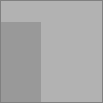 p3.dbn p3.dbn |
paper 40
pen 30
repeat a 0 100
{
line a 100 a 80
line 100 a 40 a
}
|
| |
Create a program to draw a single filled rectangle. Again, choose carefully.
|
Part 4
|
 p4.dbn p4.dbn |
paper 60
repeat a 25 77
{
pen a
line a 25 a 75
pen 60
line ((a/3)+50) a 0 a
pen 60
line 0 (a+25) (25+a) 0
}
|
| |
Create a program to draw a single filled triangle. Use your good judgement.
|
Part 5
|
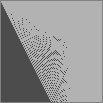 p5.dbn p5.dbn |
paper 70
repeat a 0 200
{
pen 30
line 100 100 (a/2) (100-a)
}
|
| |
Think of all the ways you can draw a filled triangle, and choose one. Utilize the properties of the drawing method you choose, to create a single filled triangle.
|
Part 6
|
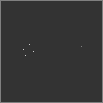 p6.dbn p6.dbn |
paper 80
set [28 57] 20
set [32 50] 20
set [22 52] 20
set [24 46] 20
set [80 55] 50
|
| |
Set 5 dots on a paper of your choice. Evoke an emotion with your choice in placement of dots.
|
Part 7
|
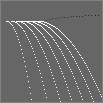 p7.dbn p7.dbn |
paper 60
repeat b 0 40
{
set [(45+(b*b/16)) (81+(b/5))] (60+b)
}
repeat a 1 7
{
repeat b 0 100
{
set [(b+(a*5)) (80-(b*b)/(a*8))] 0
}
}
|
| |
Create a representational picture (i.e. something that looks like something) using just 8 (at maximum) dotted lines.
|
Part 8
|
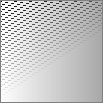 p8.dbn p8.dbn |
repeat A 1 20
{
set [0 (A*5)] (A*5)
}
repeat X 1 25
{
repeat Y 0 20
{
repeat I 4 0
{
repeat J 3 0
{
set temp [((X*4)-J-3) ((Y*5)-I-2)]
set [((X*4)-J) ((Y*5)-I)] (temp+1)
}
}
}
}
|
| |
Using a nested loop, fill the entire field with the value of some calculation that can be appreciated. Do not use the Line command.
|
Part 9
|
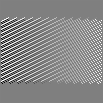 p9.dbn p9.dbn |
paper 50
repeat x 0 50
{
repeat y (5-(x/4)) (20-(x/4))
{
set [(x*2) ((y*4)+x)] x
set [((x*2)+1) ((y*4)+1+x)] x
set [((x*2)) ((y*4)-1+x)] ((50-x)*2)
set [((x*2)+1) ((y*4)-2+x)] ((50-x)*2)
}
}
|
| |
Using a nested loop, create a stippled pattern of dots that can be enjoyed for its complexity. Do not use the Line command.
|
Part 10
|
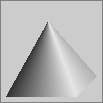 p10.dbn p10.dbn |
paper 20
repeat x 0 70
{
repeat y 0 20
{
pen (100-x-y)
line (x+25-y) (25-y) 47 80
}
}
|
| |
Using the Line command, and a (few) nested loop, create an image that evokes a three-dimensional feeling through shading.
|
 p1.dbn
p1.dbn 

 p2.dbn
p2.dbn  p3.dbn
p3.dbn  p4.dbn
p4.dbn  p5.dbn
p5.dbn  p6.dbn
p6.dbn  p7.dbn
p7.dbn  p8.dbn
p8.dbn  p9.dbn
p9.dbn  p10.dbn
p10.dbn